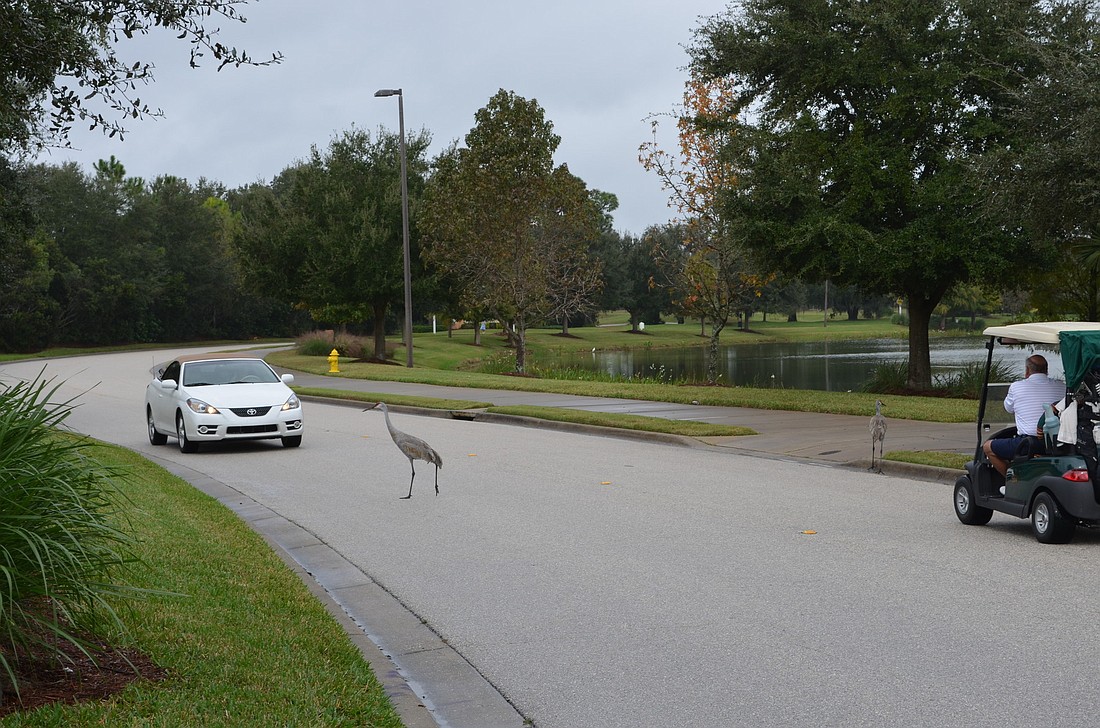- April 25, 2024
-
-
Loading

Loading

EAST COUNTY — East County has another type of snow bird influx that is back for the season, clogging area roads.
Hint: It’s the Ranch’s new mascot — the sandhill crane.
Although Lakewood Ranch Town Hall Director of Operations Ryan Heise receives phone calls weekly from residents who marvel at the birds and want more information on the animals, the “overly social” birds can pose potential hazards to drivers, particularly along Lakewood Ranch Boulevard.
Why?
They stand in the road, squawking at motorists who are forced to drive around them.
That’s because the span of wetlands surrounding the mostly two-lane stretch of Lakewood Ranch Boulevard is an appealing choice for the feathery jaywalkers.
Making matters worse, the birds aren’t typically afraid of humans and are more social than other types of birds, which can be to their detriment.
Sandhill cranes will tap on residents’ windows and doors looking for food and won’t hesitate to get into a driver’s vehicle.
In October, two sandhill cranes created a traffic jam on southbound Lakewood Ranch Boulevard as they stood in the right lane for more than 20 minutes. The cranes forced motorists to move to the left lane and maneuver around them.
Ed Straight, owner of Bradenton Beach-based wildlife rehabilitation organization Wildlife Inc., has also received a few phone calls recently from Ranch and East County residents who reported vehicles hitting the birds along University Parkway, Lakewood Ranch Boulevard and other local roads.
“The sandhill cranes don’t care if they’re stopping traffic or slowing people down,” Straight said. “They will walk into the road and drivers have to yield to them.”
Ranch resident Bob Bronston said his neighbors saw a bird get hit on Lakewood Ranch Boulevard in mid-November.
“They’re great ambassadors to our community and we have to look out for them,” Bronston said.
While the Ranch houses some year-round sandhill cranes that have decided to become fulltime Floridians, there are more of the cranes in East County and in Florida from November through March than any other time of the year.
“They march to the beat of their own drum, which I appreciate,” Heise said.
The birds travel from northern parts of the United States, Canada and other cold-climate areas to more southern states for the winter. Sandhill cranes will be mating and nesting throughout the area before the majority of the flock heads north for the summer.
Sandhill cranes prefer to live near the lush areas and feed on worms and vegetation wetland areas encourage, according to Florida Fish and Wildlife Conservation Commission scientist Tim Dellinger.
Manatee County Sheriff’s Office spokesman Dave Bristow has one piece of bird advice.
“Just be alert,” Bristow said. “That’s what drivers should be doing when driving.”
Feeding frenzy
For 28 years, Ed Straight has rehabilitated sandhill cranes and other types of wildlife at Wildlife Inc. in Bradenton Beach.
He receives multiple phone calls a week from residents, especially in East County, who report seeing a crane limping or favoring a leg.
Straight said the limping cranes are suffering from a calcium deficiency caused by people feeding the birds bread. That’s a common misconception though because bread isn’t OK for birds to eat.
The carbohydrate affects the birds’ bones, causing what Straight coins “rubber bones syndrome.”
To rehabilitate cranes that suffer from the disorder, Straight tries to change the birds’ diet and feeds them grains and other foods.
“Cranes are more social than most birds,” Straight said. “They tap on windows and doors and say, ‘Where’s my food?’ Feeding the birds bread is becoming a major problem.”
Although Straight recommends individuals don’t feed the cranes at all, grains and seeds are healthier options.
For more information, call 778-6324.
FAST FACT
• Life span (in the wild): 20 years
• Weight: 6.5 to 14 pounds
• Height: 31.5 to 47.2 inches
• Food preferences: Plants, grains, mice, snakes, insects, or worms
• Home of choice: Freshwater wetlands